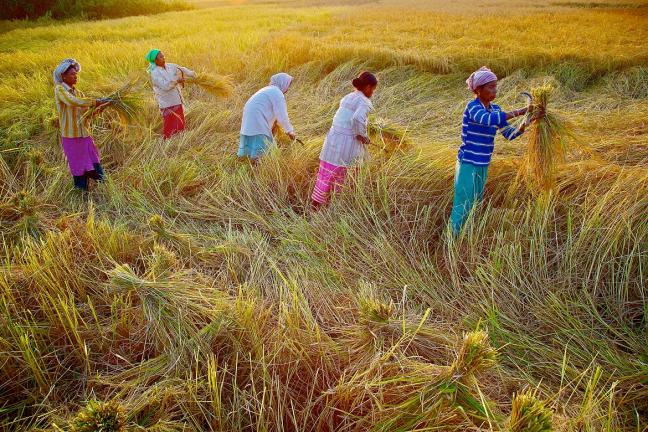Standing in muddy agricultural fields, covered from head to knee with a long plastic sheet, their backs bent forward, they work long hours to plant paddy in the monsoon season. Some have little kids tied to their backs. You must have also seen them squatting amid tall juicy sugarcanes during harvest time. Or, just sitting on their haunches, painstakingly removing weeds.
These rural women — the farmers — form the backbone of our agriculture sector, but remain neglected in the various agricultural policies and farming schemes in the country.
Today, January 18, thousands of farmers protesting against the three farm laws for the past 55 days in New Delhi, are observing Mahila Kisan Diwas, or Women Farmer’s Day. Nine rounds of talks with the Central government are already over without any solution in sight. The matter is also before the Supreme Court, which has formed a committee to look into the matter. Protesting farmers have planned tractor rally on January 26.
A large number of women farmers are a part of these protests in Delhi. And, the Mahila Kisan Diwas programme aims to honour them for their incredible contribution to the recent protests and the agriculture sector of the country.
However, a recent rapid survey of the farmers’ protest sites by Jan Swasthya Abhiyan (Delhi and Haryana) found that “there is no proper lighting system. It makes using any type of toilet facility difficult after dark, especially for the women who have come from far flung areas and are putting up at the protest sites. There is no covered and safe place for bathing for them. Consequently, these women let go of bathing for days, which compromises their hygiene” (SIC).
The report goes on to note that women farmers “are also avoiding eating food and drinking water in sufficient quantities to delay the use of washrooms, though some of them have made a makeshift toilet for themselves. Most women have brought sanitary napkins with them from home but are encountering problems in disposing them off as there is no proper means available for disposal of sanitary napkins.”
But the problems of women farmers in the country are manifold. Do you know seven out of 10 rural women work in the agriculture sector, mostly as daily wage labourers, under highly exploitative working conditions? And barely 13 per cent of these women own land.
The number of women agricultural labourers has risen in the country — from 49.5 million in 2001 to 61.6 million in 2011 — a jump of about 24 per cent. But they increasingly face violence and sexual attacks while they work in the fields.
As per a 17-country study in 2018, undertaken by Corteva Agriscience, the agriculture division of Dow-DuPont, about 78 per cent of women farmers in India face gender discrimination.
According to a research by the Food and Agriculture Organization of the United Nations, in the Indian Himalayas, a pair of bulls works 1,064 hours, a man 1,212 hours, and a woman 3,485 hours in a year on a one-hectare farm. A research by the Indian Council of Agricultural Research in nine states shows that women’s participation in the production of major crops is up to 75 per cent.
For the same amount of labour put in the fields, women agri workers are paid almost half the wage as their male counterparts. For instance, in the samba crop season, a male agriculture labourer in Thanjavur, Tamil Nadu, gets paid a daily wage of Rs 500 to Rs 600 a day, but a woman farm labourer is paid just Rs 200 to Rs 400 a day. In states such as Bihar, it is much lower for women agri workers.
Despite participating in all agricultural activities, barely 13 per cent of women in the agriculture sector own land due to the patriarchal nature of our society. Because they do not have ownership, women are not recognised as farmers. In the absence of such distinct recognition, women cultivators remain ineligible for several schemes that state and central governments have announced for improving the status of the agriculture sector.

Gaon Connection, India’s biggest rural media platform, has been regularly reporting on women farmers in the country. While thousands of farmers from Punjab are stationed at Delhi to protest the new farm laws, it is the women farmers who have taken on the mantle of looking after the farmlands and carrying on rabi crop activities.
At the same time, there are thousands of women farmers camping in Delhi participating in the protests against the new agriculture laws, which they fear favour big private companies and will further impoverish the farmers. These farmers have been demanding a repeal of the contentious laws.
In its report, among other things, the Jan Swasthya Abhiyan has demanded proper sanitation facilities in the form of adequate number of mobile toilets and regular cleaning of these toilets at the farmers’ protest sites.
Women farmers fight an uphill battle simultaneously on several fronts — land ownership, safety in the fields, equal wages, access to government schemes and a distinct identity.


















